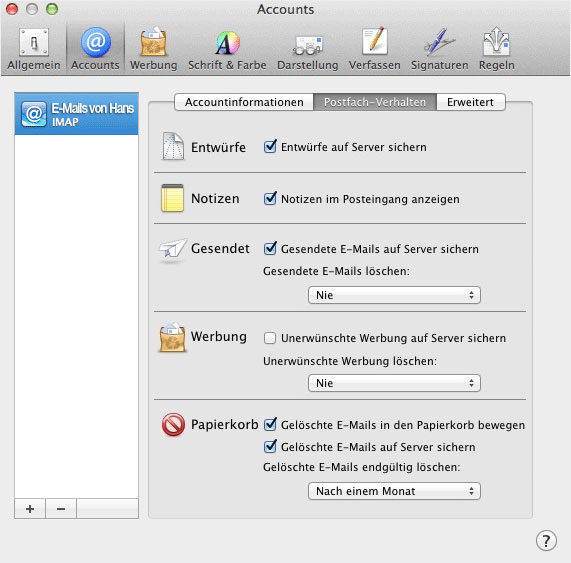APPLE – Mail (Mac OS X)
Once you have set up the email address in My Panel, you can then add the account to Apple Mail on your Mac. Follow these steps:
Automatic configuration
You can configure your email address as an IMAP account in Apple Mail on your Mac.
Open the following page in Safari: Apple – Automatic configuration
Manual configuration
If you have problems with the automatic configuration, follow the instructions below to set up your email address manually.
1. Open settings
Open Apple Mail and go to Mail → Preferences.

2. Add
At the lower left, click the + to add a new account.

3. Login details
Full name: Enter your first and last name or company name. (This is entirely up to you.)
Email address: Enter the email address you want to configure.
Password: Enter the password for the email address you set previously in My Panel. If you do not know the password, refer to the instructions for changing your email password.
Click Continue.

4. Incoming mail server
Description: Enter a description for the incoming mail server as desired.
Server type: Select POP3 or IMAP. We recommend using IMAP to access your emails because the emails remain saved on the server. This allows you to read emails from different computers and mobile devices as well. With POP3, the emails are deleted from the server after they are downloaded to your Mac.
Incoming mail server: Enter lx#.hoststar.hosting. (The first letter of the server name is a small L like Linux. Replace # with the effective server number of your hosting).
User name: The username is the email address you want to configure.
Password: Enter the password you entered in the last step.
Click Continue.

5. Security for incoming emails
If you want to use SSL encryption, enable the Use SSL option.
Under Authentication, select Password.
Click Continue.

6. Outgoing mail server
Description: Enter a description for the outgoing mail server as desired.
Outgoing mail server: Enter lx#.hoststar.hosting. (The first letter of the server name is a small L like Linux. Replace # with the effective server number of your hosting.).
Use authentication: Authentication must be enabled.
User name: Enter the email address you want to configure.
Password: The password for the email address you set previously in My Panel. If you do not know the password, refer to the instructions for changing your email password.
Click Continue.

7. Information about the outgoing mail server
If you want to use SSL encryption, enable the Use SSL option.
Under Authentication, select Password.
Click Continue.

8. Check
Check your settings and then click Create.
You have now finished setting up your email account.

9. Edit SMTP server list
If you are having difficulties sending emails with the account you have set up, check the SMTP settings.
Select SMTP server from the drop-down list. Then click Edit SMTP server list....

10. Check and change the SMTP settings
Select the SMTP server you have configured. The following SMTP settings are displayed:
Description: Enter a description for the account as desired.
Outgoing mail server: Enter lx#.hoststar.hosting. (The first letter of the server name is a small L like Linux. Replace # with the effective server number of your hosting.).
Next, click the Advanced tab.

11. Advanced settings
Check the settings for the selected SMTP server.
Select Use custom port and enter 587 for the SMTP port. If you have enabled SSL for the outgoing mail server, change the port to 465.
Depending on the port and SMTP server name that have been entered, enable or disable the Use SSL option.
Under Authentication, select Password, or you will not be able to send emails.
Check whether the username and password for your email address are entered correctly:
User name: Enter the email address you want to configure.
Password: The password for the email address you set previously in My Panel. If you do not know the password, refer to the instructions for changing your email password.
Then click OK to save the settings and return to the Accounts overview.

12. Mailbox Behaviours
Click Mailbox Behaviours to make any desired changes.
For example, you can choose whether to save Drafts, Sent messages, spam messages (Junk) and deleted messages (Trash) on the server.

13. Advanced
Here you can configure advanced IMAP or POP3 settings.
IMAP: If you enter INBOX in the IMAP Path Prefix box, Apple Mail will not recognize the folder in the mailbox correctly.
For POP3: Select whether to delete emails from the server after they have been downloaded, and after what period.
The port for the incoming mail server varies depending on the protocol you have selected (POP3 or IMAP) and whether SSL is enabled. Depending on the configuration, select the following port:
- IMAP without SSL: 143
- IMAP with SSL: 993
- POP3 without SSL: 110
- POP3 with SSL: 995
Under Authentication you must select Password so that Apple Mail can retrieve emails.
